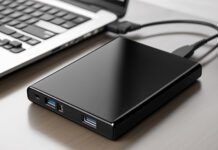If you are mixing a full worship team with a band then you will need a larger mixer. Professional-level mixers are better suited for groups who have multiple inputs and need an extensive array of audio controls.
Professional models come with significantly more channels, which allows you to handle complex sound setups without running out of input options. Many also include digital effects processing, USB connectivity and other features that make it easy to tweak your sounds on the fly.
4. Choosing A Power Amplifier
Power amplifiers are designed to boost the audio signal from your mixer so that it is strong enough for your speakers. If you’re not familiar with sound systems, then this part may seem confusing—but don’t worry!
A power amplifier will only amplify the electrical energy coming through a preamp or microphone input which means they can be connected to any type of mixer. All you need to do is make sure that your power amp has enough wattage and channels for the sound system that you’ve designed.
Professional-level amplifiers are much more powerful than entry-level models, which means they will be able to handle complex setups without breaking a sweat.
Power amplifiers are rated by the number of watts of power they produce. For a large worship space with multiple speakers, you will need an amplifier that can put out at least 500 watts of power per channel.
Smaller worship spaces can get away with a smaller amplifier which is why professional-level models are often available in smaller wattages.
5. Where To Place The Equipment
The speakers and stage monitors go on stage or near the platform area where they can be seen and heard by everyone. If your worship team is playing music with an electric guitar, bass, and drum set then you will also need to make sure that there are speakers for those instruments in front of the band as well.
Microphones should typically go on stands on the stage so that they are facing the musician or instrument they are capturing. The lead vocalist as well as the backup vocalists will need their own mic, as well as a backup in case anything goes wrong with either one during the service. Your pastor will need a pulpit mic or a lapel mic as well.
The mixer and power amp should be located at the rear of the auditorium in a sound booth. You don’t want a lot of extra wires and cables cluttering up the walkway, so make sure that everything is hidden away from view.
6. How To Set Up The Sound System
Now it is time to set up your sound gear. Here are some tips to help you build a church sound system from scratch.
Build A Sturdy And Attractive Sound Booth To House Your Sound Gear
A sound booth is an enclosed space with partial height walls. The booth needs to be large enough to house your mixer, power amp, microphones, and other equipment such as AV equipment safely away from the congregation.
You will need to make sure you have openings either in the floor or the ceiling to run all the cables you need to run from the booth to the front of the church sanctuary.
Install All Necessary Wiring In The Walls, Ceiling, Or Flooring
You will need to run what is called an audio snake from the platform to the sound booth. This is a very long cable that runs all of the necessary cables from the stage to your mixer. It will be hidden away out of sight, but you need to make sure it has proper openings in the floor or ceiling where it can run through into its final destination.
Learn How To Connect All The Wiring Together
You will need to connect all the microphones to the audio snake. You will then need to run the audio snake from the platform to the sound booth. You will need to connect all the outputs of the snake into the inputs of your mixing board. Make sure your connections on stage correspond to the channels on your snake that you connect to your mixer.
Once this is done, then you will need to connect the main and monitor outputs of your mixing board to your power amplifiers. The exception to this is if you are using active speakers. If you are using active speakers or monitors, then you skip this step.
Once you have connected the main and monitor outputs from your mixer to your power amplifiers, you then connect the outputs from your power amplifiers into the audio snake and send the signal back to the stage.
You then connect the audio snake to the speakers or monitors on stage. This should complete the connection and your mics and instruments should be heard from the speakers.
Test Out Your New Sound System With Music Before Using It For Church Services
Once you have connected all of your sound gear and checked to make sure everything is working properly, then it is time for the final test.
Before using the sound system in a church service, run through some music that will show off both your great speakers as well as any other instruments on stage. Make sure every instrument sounds fantastic including bass drums, guitars, and keyboards.
If you are using monitors, make sure the monitor levels are set appropriately for each musician on stage so they can hear themselves properly while playing their instrument. Make any adjustments that need to be made before you start your church service or another event with your new sound system!
Sound Gear Selection and Set-up: Conclusion
At Bible College when I went they didn’t teach a class on selcting sound gear and building a church sound system. I had to learn by the school of hard knocks. Hopefully, the experiences I have had over the years have helped you put together the right sound gear for your church.
This article on selecting and setting up sound gear originally appeared here, and is used by permission.











